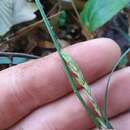Description
provided by eFloras
Culms densely tufted, central or lateral, ascending or slightly decumbent, 45–62 cm × 0.5–1 mm. Leaves: basal sheaths tan or light brown; sheaths green, sometimes glaucous, 4–88 mm; blades green, sometimes glaucous, midrib and 2 lateral veins developed, flat or slightly corrugate, 30–46 cm × 3–14 mm, blades of overwintering leaves smooth or, rarely, sparsely papillose abaxially. Inflorescences: peduncles of proximal spikes 0–5 cm, arising from proximal 1/3 of culms, 1.4–3.3(–5.3) times as long as spikes they subtend; of terminal spikes 0.4–12 cm. Bracts 0.6–14 cm × 0.8–6 mm, bract blades of distal lateral spikes linear, narrower than spikes, widest bract blade of distalmost lateral spike 0.5–3.4 mm wide. Spikes 3(–4) per culm; lateral spikes 22–62 × 3–5 mm; distal lateral spikes separate; terminal spike linear to linear-clavate, 22–32(–36) × 2–3 mm. Pistillate scales 3.4–5 × 1.2–2.2 mm, apex aristate, apiculate, or acute. Staminate scales oblong-ovate, 3–5 × 1.2–2 mm, margins hyaline or, occasionally, light brown, apex obtuse or acute. Anthers 3–3.2 mm. Perigynia 6–18 per spike, scattered to loosely overlapping, ratio of longer lateral spike length to perigynia number 1.9–3.4, ascending, finely, conspicuously (22–)25–32-veined, elongate, (3.4–)3.9–5.1 × 1.2–2 mm; beak straight or slightly curved, 0.6–1.7 mm. Achenes elongate-obovoid, 2.2–2.8(–4.6) × 1–1.8 mm. 2n = 36, 40.
- license
- cc-by-nc-sa-3.0
- copyright
- Missouri Botanical Garden, 4344 Shaw Boulevard, St. Louis, MO, 63110 USA
Distribution
provided by eFloras
Ala., Ark., Conn., Del., D.C., Fla., Ga., Ky., La., Md., Miss., N.J., N.Y., N.C., Pa., S.C., Tenn., Tex., Va., W.Va.
- license
- cc-by-nc-sa-3.0
- copyright
- Missouri Botanical Garden, 4344 Shaw Boulevard, St. Louis, MO, 63110 USA
Comprehensive Description
provided by North American Flora
Carex striatula Michx. Fl. Bor.-Am. 2: 173. 1803
Carex anceps var. striatula Carey, in A. Gray, Man. 554. 1848. (Technically based on C. striatula
Michx.) Carex ignota Dewey, Am. Jour. Sci. II. 8: 348. 1849. (Type from Louisiana.) Carex laxiflora var. striatula Carey, in A. Gray, Man. ed. 2. 524. 1856. (Technically based on C.
striatula Michx.) "Carex laxiflora Lam." Boott, 111. Carex 35. pi. 89. 1858. Carex laxiflora var. Michauxii L. H. Bailey, Mem. Torrey Club 1 : 32. 1889. (Based on C. striatula
Michx.) Carex laxiflora var. divaricala L. H. Bailey, Mem. Torrey Club 1: 33. 1889. (Type from District
of Columbia.) Carex laxiflora f. striatula Kiikenth. in Engler, Pflanzenreich 4 2 °: 526. 1909. (Based on C. striatula
Michx.) "Carex laxiflora var. palulifolia Dewey" W. Stone, Rep. N. J. Mus. 1910: 302. 1911.
Rather loosely cespitose, the rootstocks more or less prolonged, the clumps mediumsized, the culms lateral and aphyllopodic, and some central and phyllopodic, 2-6 dm. high, exceeding leaves, erect or ascending, comparatively stout, sharply triangular, not winged, smooth or nearly so, not white-striolate, not flattened in drying, brownish at base; sterile shoots reduced to tufts of large leaves and not forming long conspicuous culms; leaf-blades of the sterile shoots ascending, flat, thickish, stiff, long-persistent, 7-14 mm. wide, the welldeveloped ones 2.5-3.5 dm. long, roughened on the margins and towards the apex on the veins, acute, the edges usually strongly parallel, the midvein prominent on the lower surface and the two mid-lateral veins on the upper, the superficial cells often very prominent, not whitestriolate except near apex; leaves (not bracts) with well-developed blades 2-4 to a fertile culm, the blades similar but smaller, the sheaths long, enlarged upward, very minutely serrulate, appearing smooth, very thin ventrally, the ligule very long and prominent; staminate spike linear, subclavate, usually strongly peduncled, 2-4 cm. long, 2-3.5 mm. wide, the scales oblong-obovate, obtuse or acutish, w r hite-hyaline with 3-nerved green center, more or less yellowish-brown-tinged, the peduncle slightly ancipital, nearly smooth; pistillate spikes 2 or 3, widely separate, erect, the upper short-exsert-peduncled, the lower on peduncles exserted 1)^-3 times the length of the spikes, the peduncles ancipital, smooth, the spikes linear-oblong, 1.5-5 cm. long, 5 mm. wide, containing 6-20 loosely arranged, ascending or somewhat spreading perigynia in few rows; bracts strongly sheathing, leaf-like, usually shorter than culms, their sheaths smooth, often yellowish-brown-tinged ventrally at mouth and prolonged beyond base of blade; scales ovate, awned, cuspidate or acuminate, white-hyaline with 3-nerved green center, narrower than and about half the length of the perigynia; perigynia elliptic-obovoid, not at all inflated, obtusely triangular below, 4-5 mm. long, 2 mm. wide, glabrous, subcoriaceous, yellowish-green or brownish-green, strongly many-nerved, stipitate, tapering to a spongy base 0.5-1.5 mm. long, and tapering or somewhat abruptly narrowed into a straight or slightly excurved conspicuous beak 0.5-1 mm. long, the orifice oblique, whitish; achenes oblongobovoid, closely filling body of perigynium, 2.5 mm. long, 1.75 mm. wide, triangular with concave sides and blunt angles, granular, brownish, sessile, short-apiculate, jointed with the very short, often bent, slender style; stigmas three, slender, reddish-brown; anthers 4-5 mm. long.
Type locality: "Hab. in Carolina."
Distribution: Dry woodlands, largely on the coastal plain, Florida to Texas, northward to Connecticut and southern New York, and in the interior to Indiana. (Specimens examined from Connecticut, New York (Staten Island), New Jersey, Pennsylvania, Delaware, Maryland, District of Columbia, Virginia, North Carolina, South Carolina, Georgia, Alabama, Florida, Mississippi, Louisiana, Texas, Tennessee, Kentucky, Indiana.)
- bibliographic citation
- Kenneth Kent Mackenzie. 1935. (POALES); CYPERACEAE; CARICEAE. North American flora. vol 18(5). New York Botanical Garden, New York, NY

